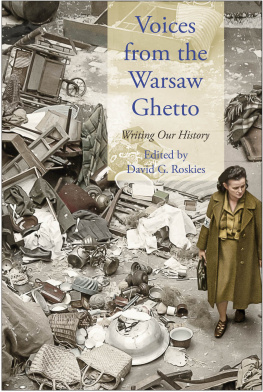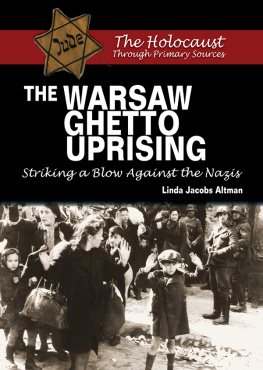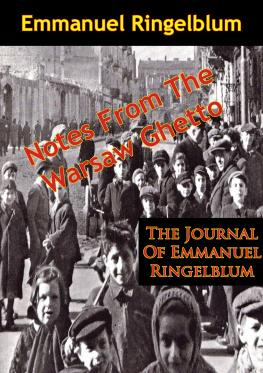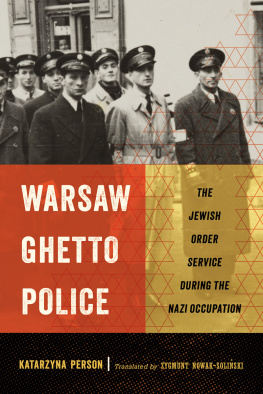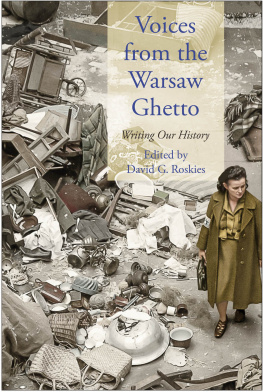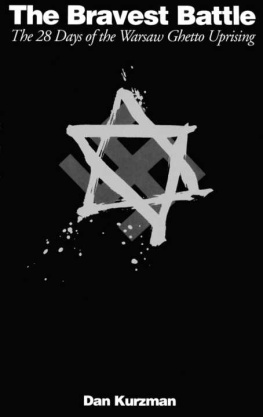Voices from the
Warsaw Ghetto

Published with assistance from the foundation established in memory of Amasa Stone Mather of the Class of 1907, Yale College.
Copyright 2019 by Yale University.
All rights reserved.
This book may not be reproduced, in whole or in part, including illustrations, in any form (beyond that copying permitted by Sections 107 and 108 of the U.S. Copyright Law and except by reviewers for the public press), without written permission from the publishers.
Yale University Press books may be purchased in quantity for educational, business, or promotional use. For information, please e-mail (U.K. office).
Set in Minion type by IDS Infotech Ltd.
Printed in the United States of America.
Library of Congress Control Number: 2018958129
ISBN 978-0-300-23672-9 (hardcover : alk. paper)
A catalogue record for this book is available from the British Library.
This paper meets the requirements of ANSI/NISO Z39.48-1992 (Permanence of Paper).
10 9 8 7 6 5 4 3 2 1
To the memory of
Leyb and Esther Rochman,
two of the surviving remnant
Contents
Foreword
Samuel D. Kassow
The members of Oyneg Shabes had few illusions about their survival, but they believed in their mission. Theirs was a battle for memory, and their weapons were pen and paper. In Majdanek, Ringelblums teacher, the historian Isaac Schipper, told a fellow inmate that what was usually known about murdered peoples was what their killers chose to say about them. The members of Oyneg Shabes did all they could to make sure that the Germans would not have the last word.
In the last weeks and months of their lives they consoled themselves with the belief that when their time capsules surfaced, they would make a difference. They would shock the worlds conscience and make it a better place. Gustawa Jarecka, asked by Ringelblum to describe the roundups on the streets of Warsaw in the summer of 1942, hoped that her words would hurl a stone under historys wheel,
But it would be safe to say that David Grabers hopes went unfulfilled. The tight-knit band of comrades forged by Ringelblum did not become the teachers and educators of the future. Even as interest in the Holocaust increased in the 1970s and 80s, few people paid much attention to the archive. Much time passed before the writings of Oyneg Shabes finally found an audience of interested scholars and readers. Very little appeared at all until the late 1980s. Even today the story of Oyneg Shabes is largely unknown.
Why was this so?
One major reason was that the Germans murdered the archives natural readership, the millions of Polish Jews who would have best understood the ethos and aspirations of Oyneg Shabesa multilingual readership that was very much at home in Yiddish, Polish, and Hebrew. Even in defeat, Hitler still won his war against these eastern European Jews, whom the Nazis especially loathed as the biological and cultural core of world Jewry. No Jewish communities in the world before the war had been as nationally conscious or as culturally creative as Polish (and Lithuanian) Jewry, despite, or perhaps because of, escalating economic and political difficulties. And Oyneg Shabes was a direct product of that prewar cultural milieu, where Jewish historians held a special place of honor as fighters who used their craft to defend Jewish honor and protect Jewish rights.
Ringelblum and Oyneg Shabes drew their inspiration from the ethos of the prewar YIVO, the Yiddish Scientific Institute founded in Berlin in 1925. The YIVO sought to convince Jews to know themselves and to collect the documents and build the archives that would make that possible. A stateless people without an army needed self-knowledge and self-respect. The YIVO wanted to study the Jews as a living community and to do so in Yiddish, the language of the Jewish masses. Everything that concerned Jews was important: their history, their folklore, their food, their jokes, how they raised their children, the songs they sang. Unbound by the constraints of conventional academia, the YIVO brought different disciplines together: psychology, history, folklore, philology, literary studiesall in an effort to study Jewish life from the ground up and not just as a record of intellectual and rabbinic elites. The YIVO brought scholars and ordinary Jews together. History by the people and for the people used the study of past and present to lay the groundwork for a better future.
Until 1942, when chilling rumors of mass murder turned into horrible reality, Oyneg Shabes to a large extent continued the YIVOs mission in the Warsaw Ghetto: collecting (zamlen in Yiddish) as a national mission and as a collective endeavor. Ringelblum, as he pointed out in his essay on the archive, wanted to study every possible aspect of Polish Jewish life during the war. No detail was too small, nothing was unimportant. And that meant everything, the good as well as the bad: corruption and demoralization along with self-sacrifice and decency, favoritism and class conflict alongside nobility and solidarity. The knowledge that Jews gained about themselves would help them rebuild after the war, identify leaders who failed, respect their own national resilience, and gain more insight into their fraught but critical relationship with their Polish neighbors.
It was even more important, Ringelblum believed, for the archive to collect as much as possible in real time. In the ghetto, life changed rapidly, and almost invariably for the worse. What seemed important today could well be entirely forgotten tomorrow. Ringelblum considered it crucial that the archive focus on the here and now, to work badly and to write as if the war was already over.
Ringelblum wanted the archive to penetrate the microcosms of ghetto life, to enter the communities of the courtyards and the house committees. He wanted writing that recorded the pulse of Jewish life and the flow of Jewish time.
What the archive collected in its early days would have been irretrievably forgotten had it waited even half a year. Real time meant recording a community that was not yet destroyed, voices that were not yet stilled, folk humor that was not yet blunted. Shimon Huberbands collection of Jewish folklore from the early days of the occupationjokes, messianic hopes, storieswas a key example of the YIVO method at work. So was Peretz Opoczynskis study of one courtyard where simple Jews, who could have been characters in a prewar Yiddish novel, gossiped, bickered, traded rumors, and tried to figure out how to survive. The brilliant young Polish-language poet Wadysaw Szlengel in his poem Telephone described the deep feelings of alienation and abandonment that he felt in the ghetto, sharing no common language with the Yiddish-speaking Jewish masses and yet finding little friendship and support from the Poles whose culture he shared.
By mid-1941 the tribulations of 1939 and 1940 seemed like a picnic. Life in the ghetto became more dire, and for those without money to buy food, their access to soup kitchens only prolonged a drawn-out process of slow starvation. Leyb Goldins Arke traces this process minute by minute, hour by hour, in a tug-of-war between total obsession with hunger and a lingering sense of humanity still contained in the written word. While Goldin and Opoczynski were writing before zero hourthe beginning of mass murderthe writings of Chaim Kaplan and Rabbi Kalonymus Shapira reflect the slow transition from rumor to horror that gripped more and more Jews in the spring of 1942. Kaplan struggles with the devastating news from Lublin, while Shapira tells his disciples that they were not to blame for their suffering. God was not punishing them for their sins but weeping with them. Would the Piaseczner Rebbe have said this in 1939? Probably not. But by July 1942 he had grasped that what he was seeing had never happened before in Jewish history.
Next page
